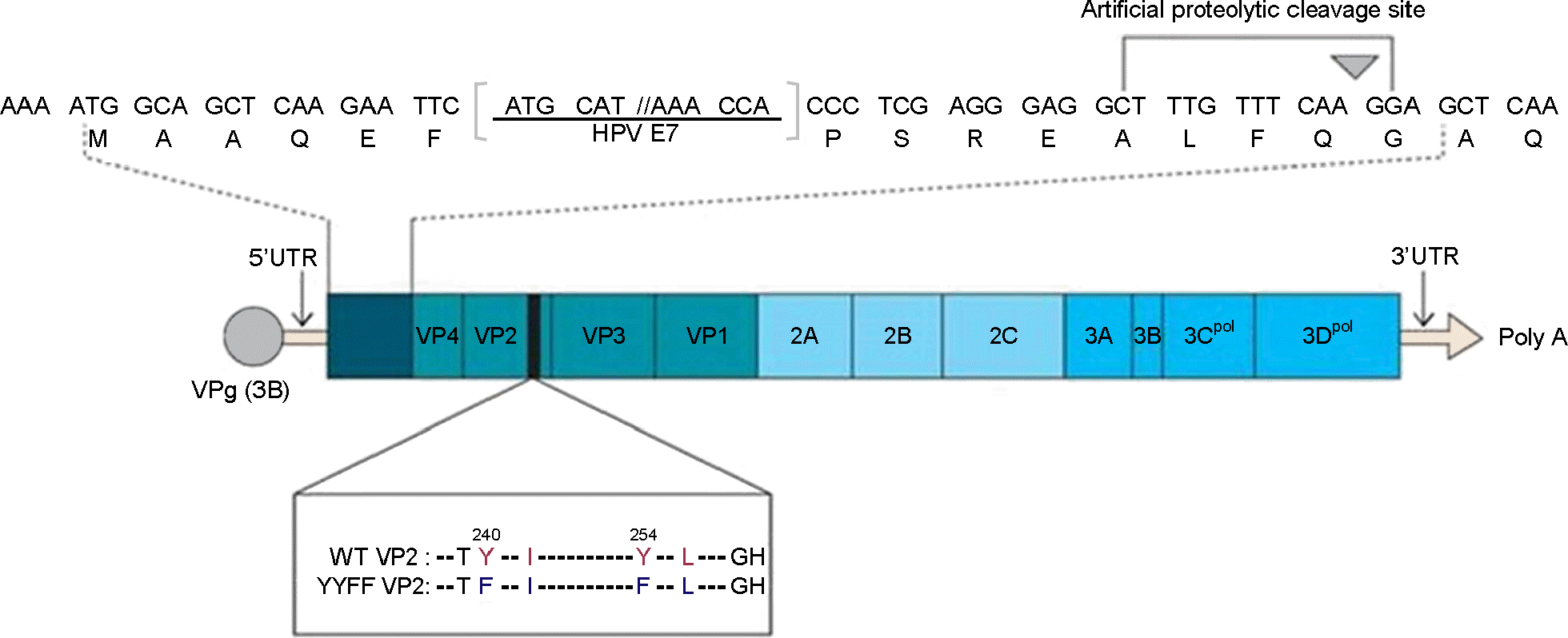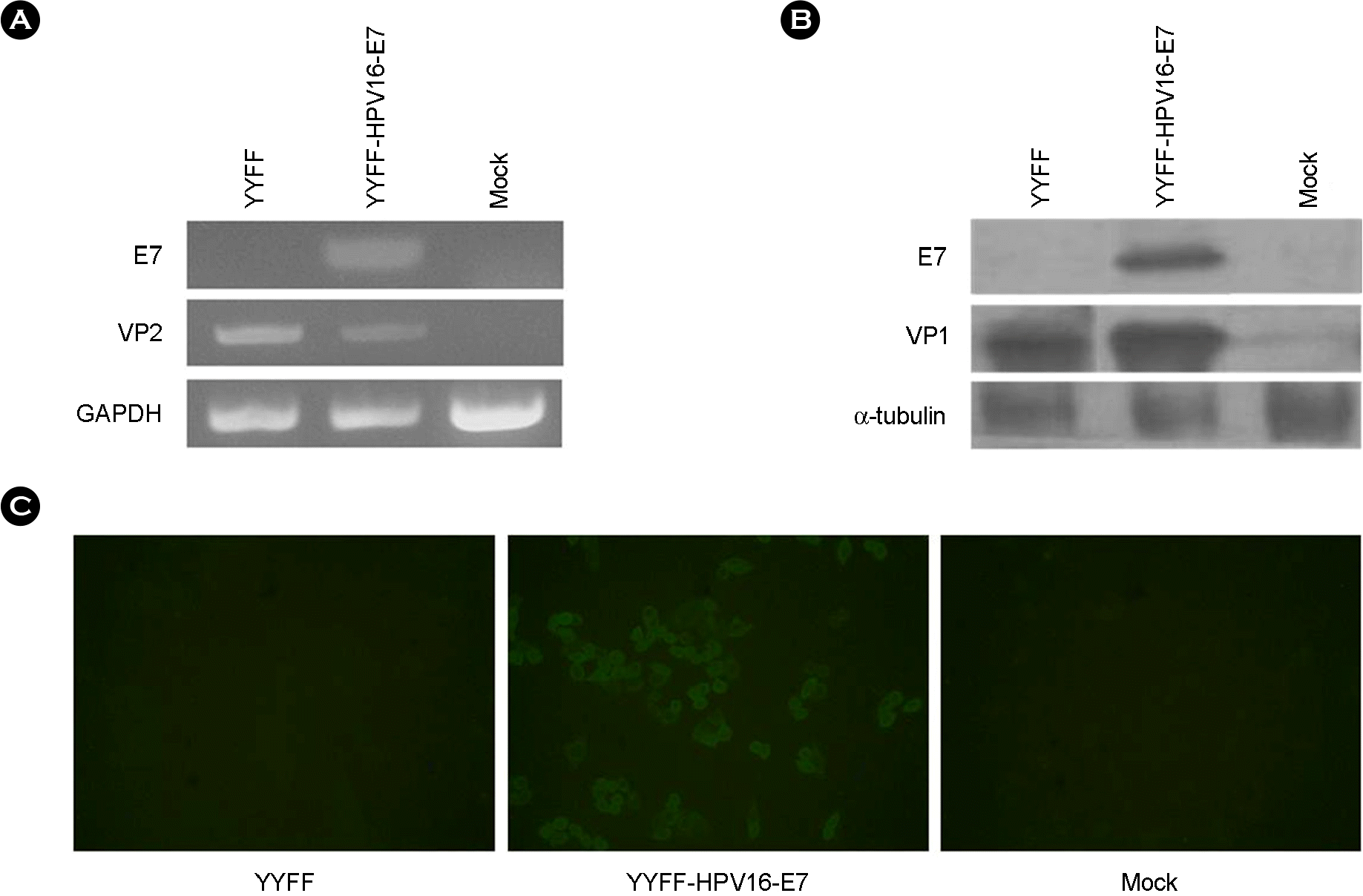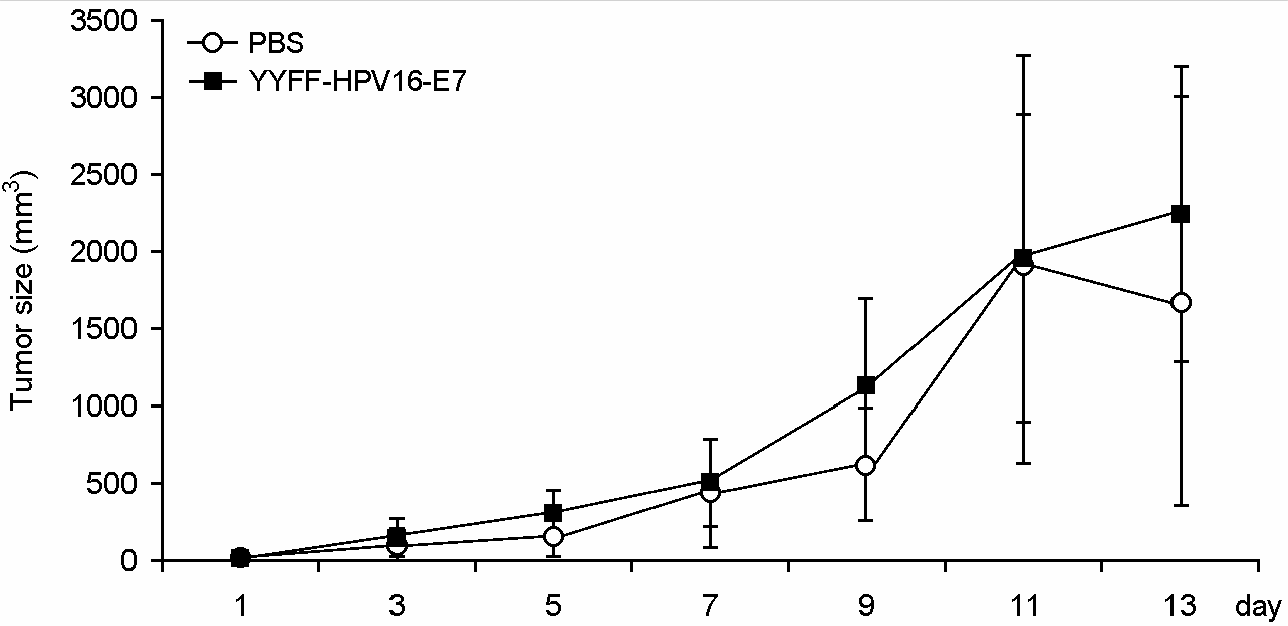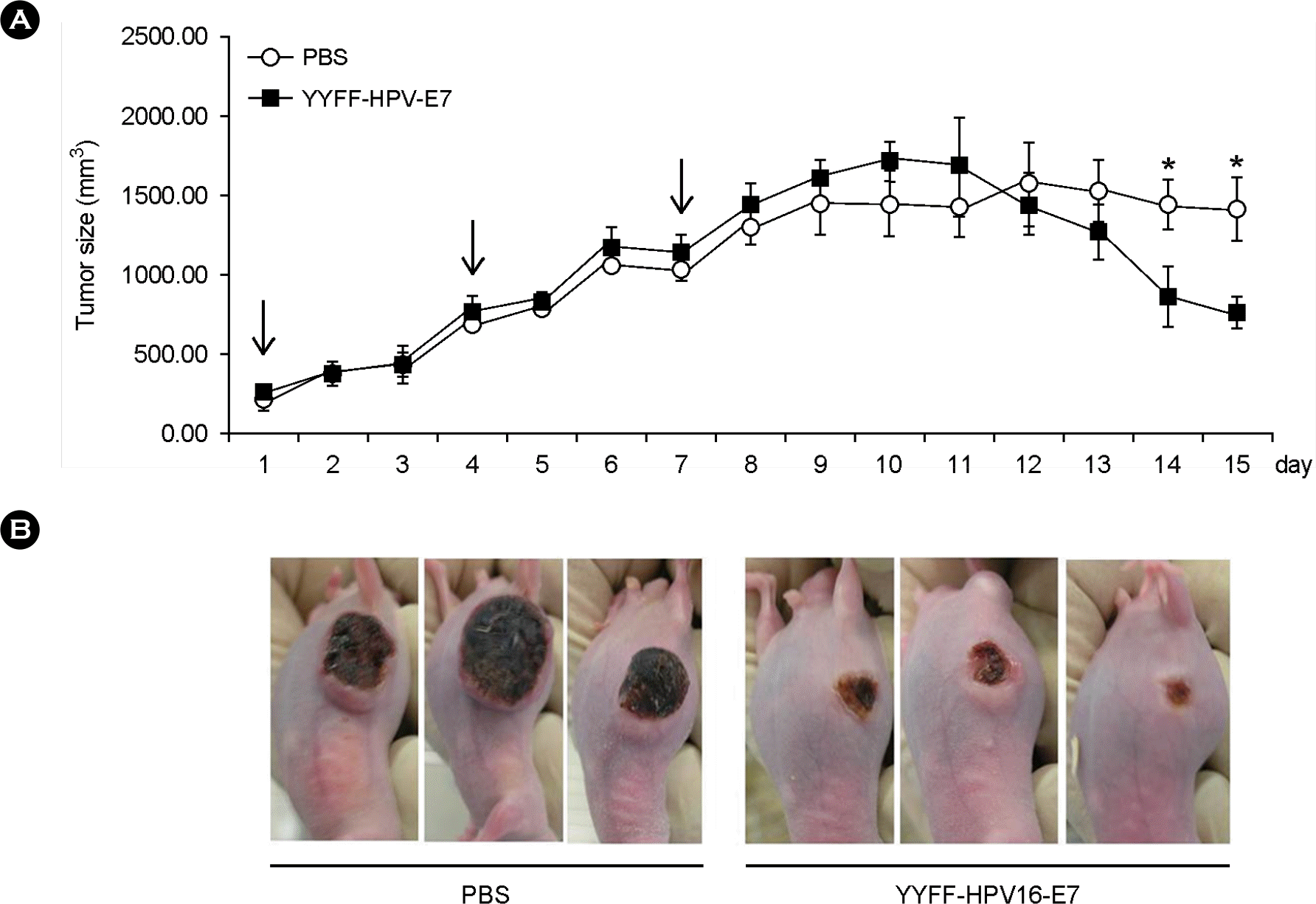Abstract
We previously reported the development of an attenuated coxsackievirus B3, known as YYFF, which functioned as a viral vector system for foreign gene expression. In this study, we demonstrated the potential use of YYFF as a gene therapy vector. Recombinant YYFF was constructed to express the human papillomavirus 16 (HPV16) E7 gene, referred to as YYFF-HPV16-E7. Growth of YYFF-HPV16-E7 resembled the wild type, YYFF, and it expressed HPV16-E7 in cell culture. When YYFF-HPV16-E7 was directly injected into TC-1-transplanted C57/BL6 mice, there was no reduction in tumor size, because of the non-growth of YYFF in C57/BL6 mice. However, when YYFF-HPV16-E7-induced immune cells/serum that originated from BALB/c mice was passively delivered into BALB/c background TC-1-transplanted nude mice, it reduced the size of cervical tumors in the nude mice. This study indicates the potential use of YYFF-HPV16-E7 as a gene therapy agent for treating HPV-induced cervical cancer.
Go to : 
REFERENCES
1). Polo JM., Dubensky TW Jr. Virus-based vectors for human vaccine applications. Drug Discov Today. 2002. 7:719–27.

2). Jiang H., Pierce GF., Ozelo NC., de Paula EV., Vargas JA., Smith P, et al. Evidence of multiyear factor IX expression by AAV-mediated gene transfer to skeletal muscle in an individual with severe hemophilia B. Mol Ther. 2006. 14:452–5.

3). Lyon AR., Sato M., Hajjar RJ., Samulski RJ., Harding SE. Gene therapy: targeting the myocardium. Heart. 2008. 94:89–99.

4). Ziello JE., Huang Y., Jovin IS. Cellular endocytosis and gene delivery. Mol Med. 2010. 16:222–9.

5). Waehler R., Russell SJ., Curiel DT. Engineering targeted viral vectors for gene therapy. Nat Rev Genet. 2007. 8:573–87.

6). Bouard D., Alazard-Dany D., Cosset FL. Viral vectors: from virology to transgene expression. Br J Pharmacol. 2009. 157:153–65.

7). Henke A., Jarasch N., Wutzler P. Coxsackievirus B3 vaccines: use as an expression vector for prevention of myocarditis. Expert Rev Vaccines. 2008. 7:1557–67.

8). Kim DS., Nam JH. Characterization of attenuated coxsackie-virus B3 strains and prospects of their application as live-attenuated vaccines. Expert Opin Biol Ther. 2010. 10:179–90.

9). Kim YJ., Yun SH., Lim BK., Park KB., Na HN., Jeong SY, et al. Systemic analysis of a novel coxsackievirus gene delivery system in a mouse model. J Microbiol Biotechnol. 2009. 19:307–13.
10). Kim DS., Cho YJ., Kim BG., Lee SH., Nam JH. Systematic analysis of attenuated Coxsackievirus expressing a foreign gene as a viral vaccine vector. Vaccine. 2010. 28:1234–40.

11). McLaughlin-Drubin ME., Münger K. The human papilloma-virus E7 oncoprotein. Virology. 2009. 384:335–44.

12). Chu NR., Wu HB., Wu T., Boux LJ., Siegel MI., Mizzen LA. Immunotherapy of a human papillomavirus (HPV) type 16 E7-expressing tumour by administration of fusion protein comprising Mycobacterium bovis bacille Calmette-Guerin (BCG) hsp65 and HPV16 E7. Clin Exp Immunol. 2000. 121:216–25.
13). Miller JP., Geng Y., Ng HL., Yang OO., Krogstad P. Packaging limits and stability of HIV-1 sequences in a coxsackievirus B vector. Vaccine. 2009. 27:3992–4000.

14). Lim BK., Shin JO., Lee SC., Kim DK., Choi DJ., Choe SC, et al. Long-term cardiac gene expression using a coxsackieviral vector. J Mol Cell Cardiol. 2005. 38:745–51.

15). Henke A., Jarasch N., Wutzler P. Coxsackievirus B3 vaccines: use as an expression vector for prevention of myocarditis. Expert Rev Vaccines. 2008. 7:1557–67.

16). He Z., Wlazlo AP., Kowalczyk DW., Cheng J., Xiang ZQ., Giles-Davis W, et al. Viral recombinant vaccines to the E6 and E7 antigens of HPV-16. Virology. 2000. 270:146–61.

17). Fazeli M., Soleimanjahi H., Ghaemi A., Farzanepour M., Amanzadeh A., Hashemi SR. Efficacy of HPV-16 E7 based vaccine in a TC-1 tumoric animal model of cervical cancer. Cell Journal. 2011. 12:483–8.
Go to : 
 | Figure 1.Construction of recombinant coxsackievirus expressing HPV16 E7 flanked by viral protein 4 (VP4). The black box in viral protein 2 (VP2) indicates the conserved amino acid sequence in the C-terminal region of the VP2 protein of coxsackievirus B3 (CVB3). The VP2 protein contains tyrosines at positions 240 and 254 in the wild-type CVB3 (WT), whereas both tyrosines are replaced by phenylalanine in YYFF VP2. |
 | Figure 2.The growth of the viruses YYFF and YYFF-HPV16-E7 in HeLa cells (MOI = 10). (A) Intracellular viral titer. (B) Extracellular viral titer at each time point as determined by plaque assay (described in Materials and Methods). YYFF (○) and YYFF-HPV16-E7 (▪). |
 | Figure 3.Expression of E7 and VP1 in HeLa cells infected with YYFF and YYFF-HPV16-E7. The HPV16 E7 mRNA was detected by RT-PCR using the specific primer set (A). The E7 protein was detected by Western blot analysis using anti-HPV E7 and anti-VP1 (B), and IFA using anti-HPV E7 (C). Mock indicates uninfected HeLa cells. |




 PDF
PDF ePub
ePub Citation
Citation Print
Print




 XML Download
XML Download